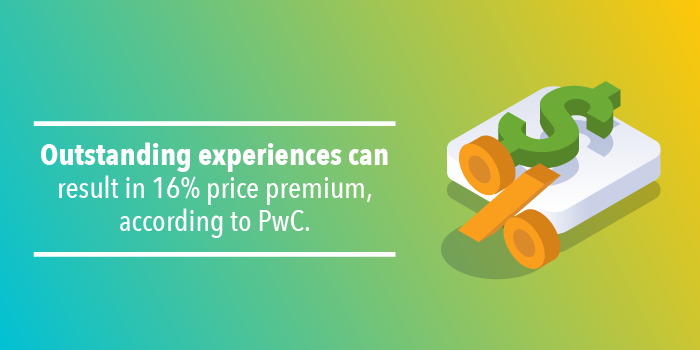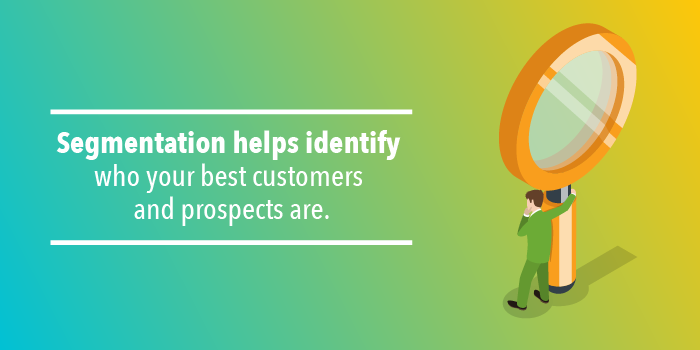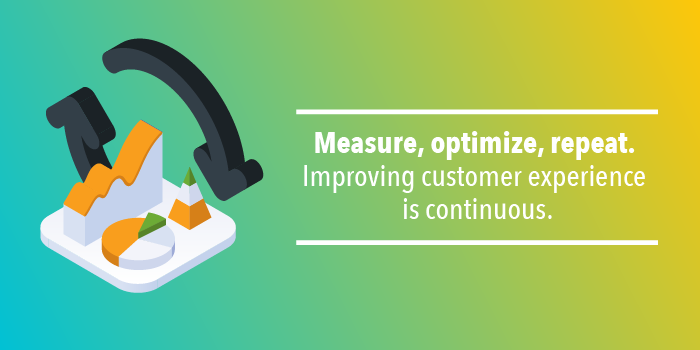
You’ve got an innovative, premium-quality product, and you know your marketing is reaching its intended audience. The sales team has been having meaningful conversations, but something still seems off. When the numbers come in, they confirm your suspicions — you’ve fallen short of reaching your goals.
Does this sound familiar? One potential issue that could be the root cause is your customer experience. In today’s digital economy, customers have more choices than ever for where to spend their money. If you don’t create the right experience for them, your competitors might.
The good news is you can determine how to improve the customer experience with big data to gain deeper insights into your customers and their journey with your brand.
What Is Customer Experience, and Why Does It Matter?
Customer experience describes the collective interactions a customer has with your brand and how they feel about those contacts. Each step in their journey with you influences their perception of your company. As a result, the customer experience covers all aspects of the relationship between companies and their customers, from initial brand awareness to after-sale support and everything in between.
There is a definitive link between a great customer experience and some key business drivers. For example, 58% of customers are willing to spend more when they receive spectacular customer service. Service is only one part of the equation, but the number jumps to 70% when customer experience factors like convenience enter the playing field.

Improving customer experience can also benefit your business in the form of increased customer satisfaction, brand loyalty and sales. According to the PwC report, outstanding experiences can result in as much as a 16% price premium on your products or services. Happy customers are also more likely to share your brand with others. Plus, as touched on earlier, creating excellent customer experiences can set your brand apart from the competition, helping you win and keep customers.
Word of mouth (WOM) is another reason the customer experience is critical to your business’s success. Recent research points out a good experience generates three times as many conversations with others as a forgettable one. With WOM leading to 90% of sales, there’s an excellent opportunity to capture more customers with stimulating and satisfying experiences. Those happy people also return, with 96% becoming repeat customers more likely to share stories about their positive experiences.
Plus, businesses are beginning to see a great experience as a differentiator. Almost half of those in a recent global survey indicated it as a primary factor for creating a competitive advantage.
Building a good customer experience can clearly lead to higher revenues, improved customer satisfaction, brand loyalty and increased market share.
The Role of Data in Measuring Customer Experience
Having the right information about your customers’ interactions with your brand is essential to understanding how to enhance customer experience. The more customer experience data you have, the better able you are to:
- Identify customer needs, whether directly or indirectly expressed.
- Meet your customers where they are.
- Create seamless omnichannel approaches.
- Allow customers to feel heard.
- Benchmark your performance against your competitors.
- Pinpoint how customers prefer to engage with your company.
- Determine potential issues and their root causes.
- Define and detail your customer journeys.
- Strategize solutions and identify opportunities.
- Highlight patterns and trends to make market predictions.
- Respond more quickly to customer needs.
- Personalize marketing to audience members and segments.
- Understand which interactions have the most impact on your bottom line.
- Meet and exceed customer expectations.
Tracking key metrics like the number of repeat customers and your satisfaction survey scores helps form a foundation of your customer experience you can build on. Other valuable information includes demographics, purchase histories, customer service data and offline behavior.
As a result, gaining customer experience data insights that matter goes beyond analyzing only traditional first-party information — this data provides a narrow view of the entire customer experience. Consider augmenting your first-party information with second- and third-party data for a more holistic perspective. Modern solutions enable you to track customers across browsers and domains, eliminate data silos and provide a more unified picture of your customers’ interactions with your brand.
How to Use Data to Improve Customer Experience
So, how can big data improve customer experience? Combining your information with robust data collection, collaboration and analysis tools gives you a powerful solution. Here are five tips for how to improve the customer experience by leveraging your unique analytics and technology.
1. Collect an Inventory of Current Customers
Improving the customer experience starts with a deeper understanding of your existing consumers and how they engage with your brand.
During this initial step, gather as much information about your customers as possible. Such data collection can include factors like:
- Demographics: What are their ages, marital statuses and income ranges? What are their occupations?
- Interests, preferences and lifestyle choices: What do they enjoy doing in their free time? What sites are they visiting, and what content formats resonate with them?
- Shopping and purchasing habits: How much and what types of products and services are they buying? How much are they researching before purchasing, and what influences their decisions?
- Existing interactions: When are they engaging with your brand, and is there a time pattern? What channels are they using to interact with you?
Great places to start collecting this information include your subscription lists, websites and apps, and email database. You’ll also find valuable data in your customer support histories, social media accounts, loyalty programs and survey results.
Once you’ve completed this process, you can eliminate duplicate or out-of-date information to ensure what remains will offer the most actionable insights to enhance the customer experience. Another key outcome of this step is identifying where gaps exist in your current information — augmenting with second- and third-party data can help fill in some of the blanks for a more comprehensive understanding.
2. Determine Where You Stand With Your Clients

The next step for understanding the customer experience is measuring their current sentiment and perceptions about your company and its products or services.
Start by looking at your existing sources for data and the customer experience, such as reviews and social media mentions. You’ll also want to check your service and support calls and chat transcripts for common denominators that can reveal challenges and opportunities for how to improve customer service.
Directly soliciting customer feedback is another savvy way to measure their sentiment. Consider deploying surveys to gather this information. Useful survey types include:
- Market research surveys to help you benchmark against the competition.
- Brand awareness surveys to gauge the most popular purchasing channels.
- Segmentation surveys to define multiple audiences.
- Net promoter surveys to determine how likely a customer is to recommend your brand.
- Customer satisfaction surveys to measure overall happiness with your brand.
You can take various approaches to ask for feedback, like posting survey invitations on your social media profiles or in a website pop-up. To encourage the best participation and get the most helpful information, you should:
- Ensure your surveys aren’t intrusive.
- Use the solicitation method your customers prefer.
- Stay on brand with messaging.
- Keep questions brief.
- Allow for some open-ended communication and ask if they’d like a follow-up contact to resolve previously unknown issues.
- Consider demonstrating the value of their responses by sweetening the deal with a coupon or a small reward for completion.
- Communicate clearly how you’ll use their feedback.
Once the responses come in, organize them in a central location for accurate analysis.
3. Map and Analyze Customer Profiles
The third step in customer experience improvement is defining your different buyers’ personas and their journeys with your brand.
Most brands boast more than one type of customer. For example, car manufacturers serve family needs with SUVs and minivans but also make sports models and work trucks.
Begin by segmenting your customers into similar groups based on their characteristics. Once you’ve done so, you can delve into more granular data. Are there commonalities between how these groups feel about your brand or how they engage with it? You may gain even greater insights to increase their customer experience by drilling down to individual levels or further segmenting your groups.
After organizing this data, it’s time to map your customer groups’ journey as they engage with you. Define each touch point and step they take, from initial brand awareness to loyal membership. When you make a visual roadmap of each segment, you can more clearly see where you’re successful and where you have an opportunity to improve. For example, if customers repeatedly call support for delayed product delivery, it may be time to adjust the expected delivery time frames or change shipping methods.
Another benefit to customer segmentation is its ability to tell precisely who your best customers are and what elements of the experience drive their sentiment. Identifying those characteristics in other groups and delivering a comparable experience can help you convert those individuals to “best customer” status.
You can take customer segmentation a step further through data collaboration. Consider partnering with another brand or even publisher, to share data insights. By overlapping your data in a secure environment, like Lotame’s data collaboration platform Spherical, you could uncover additional insights you never would have discovered without tapping into second-party data.

4. Put Data Into Practice to Appeal to Clients
Step four to creating a better customer experience is translating your knowledge into action — data is at its most powerful when you use it to transform your activities.
Look at the insights you’ve gained and use them as a basis for your customer experience improvement strategy. Maybe your survey results indicated many of your customers want faster delivery or online chat support. This information provides a clear directive for how to create a better experience for them. Plus, these results are an objective way to allocate resources and reinforce data-driven decision-making.
Once you’ve determined your opportunities for improvement, prioritize them according to need and impact. Which are most important to your customers and crucial to a better outcome? Those are the changes you’ll want to focus on first.
An additional way to put your data into action is through marketing personalization. When you tailor your customer interactions, you naturally create more meaningful experiences. Customers increasingly expect marketing to be more individualized, whether you use their names in an email or suggest additional products based on their expressed interests.
You can also actively use your data to make more seamless interactions in customer service. Your customers may use multiple channels to engage with your brand, and repeating service requests or information across them can be frustrating. By organizing and centralizing your customer data, you can prevent those issues from happening.
5. Measure Customer Satisfaction Results and Make Changes Accordingly
The final step toward an improved customer experience is to analyze your results and continue to adjust your approaches. Your data allows you to keep your finger on the pulse of what’s happening. Embrace the mindset that it’s a process, not a destination — continuous measurement and adjustment help keep you on the road to even more improvement.
Identify what strategies contribute directly to which goals, then define the vital metrics to track your progress toward success. Common key performance indicators (KPIs) include things like email click-through rates, average order value and customer churn. When you see measurable results against the metrics aligned with your goals and strategies, you can be confident that your adjustments toward a better experience are paying off.
Regularly monitoring your data provides another benefit by alerting you sooner to changes you’ve made that may not be having as much impact as you’d hoped. You can intervene faster to introduce alternatives and limit potential negative experiences. In addition, ongoing tracking of unified experience data makes spotting trends easier and quicker. As a result, you can swiftly respond to opportunities you may have missed.
Finally, a commitment to measuring results and making changes continuously allows you to repeat successes across different customer segments. You’ll have a deeper understanding of both best practices and your unique workflows.

Leverage Your Big Data to Enhance Customer Experience With Lotame
Holistic customer data delivers numerous benefits for understanding and improving the customer experience. Unleash all its power to create a competitive edge, boost revenues and increase satisfaction. Lotame makes it possible with a suite of data collaboration, enrichment and connectivity solutions.
We’ve designed powerful tools for the professional marketer and agency or publisher and media company. Our team uses a consultative approach to deliver flexibility and interoperability — you get a solution that meets your needs and helps achieve your goals while protecting consumer privacy. In addition, you’ll benefit from our extensive data technology and analytics expertise backed by unparalleled customer service.
Plus, our data marketplace allows you to fill in the blanks and increases confidence in reaching target audiences for more relevant messaging. Robust integrations make it simple to incorporate our solutions directly into your existing tech stack for easy use and the ability to push your data into the tools your team uses every day.
Ready to see how you can use your data to improve the customer experience with data? Connect with us for more information, or request your free demo today.